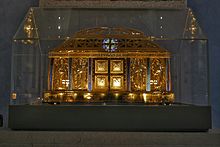Jutta von Sponheim
Jutta von Sponheim (also Jutta von Spanheim or Jutta vom Disibodenberg ; * around 1092 in Sponheim ; † December 22, 1136 on the Disibodenberg) was recluse and director ( magistra ) of a Benedictine cell on the Disibodenberg . She came from the Counts of the Sponheimers and is venerated as a blessed . Her feast day is December 22nd.
Live and act

Jutta was the daughter of Stephans and Sophias von Sponheim , a family of counts based at Sponheim Castle west of Bad Kreuznach . When she was three years old, her father died and the mother took care of the children alone.
According to tradition, Jutta fell ill so seriously at the age of twelve that her recovery seemed to be a miracle cure , and Jutta promised to dedicate her life to God. Therefore, she subsequently rejected all marriage proposals, sought out Archbishop Ruthard (1098–1109) from Mainz and, against the will of her family, took her veil at the age of 14. After her vita, Jutta was first brought up by the pious widow Uda von Göllheim at Sponheim Castle , together with her relatives, eight-year-old Hildegard von Bingen and another girl .
On November 1, 1112 (there are two sources with different dates) Jutta von Sponheim moved into a hermitage at the age of 20 at the monastery church of Disibodenberg, where she took care of the upbringing of children. Hildegard von Bingen, now 14 years old, and two other girls moved in with them. A Benedictine women's convent was created , which expanded the existing men's convent into a double monastery .
Jutta became the teacher of the young Hildegard von Bingen, who was elected Magistra of the monastery in 1136 after Jutta's death . Among other things, she wrote of her:
"God poured his grace into this woman like a stream fed by many waters, so that she would not let her body rest in waking, fasting and other good works until she concluded her earthly life with a happy ending."
Popular belief has passed down the legend that Jutta von Sponheim turned water into wine and often crossed the Glan river with dry feet .
Meginhard von Sponheim († 1135) and Hugo von Sponheim († 1137), Archbishop of Cologne, were Jutta's brothers.
Afterlife
After her death, her life was written down in a pamphlet Vita domnæ Juttæ inclusæ by an unknown author, who, however, presumably came from her immediate surroundings. Shortly after her death, miraculous phenomena were reported on her grave. Wibert von Gembloux , an advisor to Hildegard von Bingen, describes her as a blessed ( beata ) in his writings . Their veneration in the late Middle Ages is attested in the Chronicon Hirsaugiense by Johannes Trithemius (around 1500).
Jutta von Sponheim is venerated as a blessed in the Benedictine order, as well as in the diocese of Speyer , to which the Disibodenberg belongs.
On in the Sanctuary of St. Hildegard to Eibingen located Hildegardis Shrine , container for relics Hildegard, Jutta von Sponheim is displayed on the front in relief. In the monastery church in Sponheim opposite the Marien Altar are the statues of St. Jutta von Sponheim and St. Hildegard in childhood.
literature
- Franz Staab : Reform and reform groups in the Archdiocese of Mainz. From "Libellus de Willigisi consuetudinibus" to "Vita domnae Juttae inclusae" , Appendix II, in: Sources and treatises on the history of the Middle Rhine Church , vol. 68: Reform idea and reform policy in the Late Sali-Early Staufer Empire - Lectures at the conference of the Society for Middle Rhine Church History from 11 . until September 13, 1991 in Trier , 1992, p. 172 ff.
- Pilgrim calendar (year book of the Speyer diocese): Born 1951, pages 17-23, Palatinate Saints
- Ekkart Sauser : Jutta vom Disibodenberg. In: Biographisch-Bibliographisches Kirchenlexikon (BBKL). Volume 17, Bautz, Herzberg 2000, ISBN 3-88309-080-8 , Sp. 742.
Web links
- Land of Hildegard, city administration Bingen am Rhein
- von Sponheim.html Jutta von Sponheim in the portal Ökumenisches Heiligenlexikon
- Jutta von Sponheim, in the portal of the city of Bad Kreuznach ( Memento from March 31, 2008 in the Internet Archive )
- Jutta in the CERL Thesaurus
Individual evidence
- ^ About the education by Uda von Göhlheim or Göllheim
- ↑ Source on the Entry of St. Hildegard and the dating of the events
- ↑ On the folk legend
- ^ Family tree of the Counts of Sponheim
| personal data | |
|---|---|
| SURNAME | Jutta von Sponheim |
| ALTERNATIVE NAMES | Jutta von Spanheim; Jutta vom Disibodenberg |
| BRIEF DESCRIPTION | Reclamation |
| DATE OF BIRTH | around 1092 |
| PLACE OF BIRTH | Sponheim |
| DATE OF DEATH | December 22, 1136 |
| Place of death | on the Disibodenberg |

